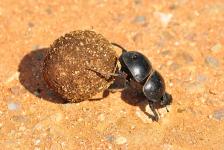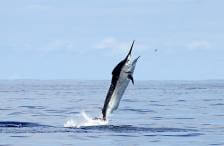How Do the Strongest, Fastest Animals Compare to Olympians?
What is the fastest animal on land? How about in water? How much can the strongest animal lift? Let’s look at how the rest of the animal kingdom would shape up against our Olympians and other World Record setters.
Fastest Animal on Land

Usain Bolt is nicknamed “the fastest man on Earth” for first setting the world record for the 100 meter dash in 2008 and then smashing his own time a year later at the World Championships. The Jamaican can run 100 meters in 9.58 seconds which gives him an average speed of 10.4 meters per second. However, since he starts from rest, he must be going slower than that average speed to start and even faster at a later point in the race. His top speed is estimated at 12 meters per second or about 27 miles per hour. Even Usain Bolt couldn’t outrun a cheetah.
But the cheetah is only fastest if we are defining speed by the time to travel across a certain distance. To level the playing field a bit to give smaller animals a chance, speed can also be measured in terms of body lengths. The cheetah can travel about 16 of its own body lengths per second – pretty impressive until you learn that the south Californian mite can move 322 of its body lengths per second. To keep up with that speed, a human would have to run nearly 1300 miles per hour.
For fun, check out the other Guinness World Records involving a 100-meter race, including the fastest 100-meter race done in clogs, the fastest moonwalked 100 meters, and the fastest time to blow a stamp 100 meters. That last one is three minutes and three seconds. Impressive!
Fastest Animal in Water
The battle for the title of fastest animal in water is between the sailfish and the black marlin. The sailfish has been clocked hurtling out of the water at 68 miles per hour or just over 30 meters per second. The black marlin may be faster, although its speed of 80 miles per hour has only been determined by how fast it pulls a fishing line off the reel.
The world record times for swimming vary a bit depending on the stroke. The 100-meter freestyle, backstroke, and butterfly records are 46.91 seconds (held by Cesar Cielo of Brazil), 51.94 seconds (Aaron Peirsol of the US), and 49.82 seconds (Michael Phelps of the US) respectively. That puts Cielo’s swimming speed at 2.13 meters per second in the water, not enough to beat the sailfish.
Fastest Animal in Air: Wing Speed
The comparison between humans and animals cannot be made so directly when it comes to air speeds, so as a substitute, we can look instead at wing speed and diving speed.
The hummingbird ordinarily has one of the fastest wingbeat rates at around 90 beats per second. However, during courtship, the ruby-throated hummingbird actually reaches wingbeat rates of 200 beats per second making it the fastest wing flapper in the animal kingdom.
In addition to his three team world records, Michael Phelps holds three individual world records, two of which are for the 100-meter and 200-meter butterfly event. (The third is for the 400-meter individual medley.) Although his tall frame and long arms are clearly built for swimming, Phelp’s stroke mechanics and technique are credited for his success.
Phelps is estimated to take 34 strokes per 50 meters. Since he can complete the 100-meter butterfly 49.82 seconds, that means he uses approximately 1.4 strokes per second. Admittedly, the comparison is a bit of a stretch, particularly given the difference between the water and air elements, but it’s the closest we humans get to flapping our “wings” without any tools to assist us.
Fastest Animal in Air: Diving Speed
Another popular summer Olympic event is diving. Of course, divers are scored based on their technique, including starting position, approach, gracefulness of flight, their entry into the water, and the degree of difficulty of their dive, so the Olympic and World Records aren’t really about speed. But since it wouldn’t be fair to judge a bird on its poise, let’s look at their speed anyway.
We can actually estimate the speed for any diver if we know their starting height (combined with our knowledge of their acceleration due to gravity). In the World Championships for the high dive, men jump from platforms around 27 meters high while women jump from 20 meters. Kinematics tells us that their ending position (a height of 0) is equal to their starting position minus one-half times the gravitational acceleration times the square of the time the dive takes. Solving for that time, a 20-meter dive will take ~2 seconds for an average speed of 10 meters per second.
The peregrine falcon, a very successful and intense predator, can dive through the air at 242 miles per hour. That’s about 389 kilometers per hour or 110 meters per second and makes them the fastest animal in the air.
Strongest Animal

On a list of the strongest animals, the grizzly bear is near the top. To test a grizzly bear’s strength, researchers from Montana smeared a dynamic testing device, one that measures the force being exerted upon it, with honey, jam, and purified fish heads (yum!) to encourage the bear to pull on it. They determined grizzly bears to be 2.5 to 5 times as strong as a human.
But lest you think we are closing the gap on the animal kingdom in the strength category, we can also define strength by body weight. If we do, the dung beetle is the clear winner. Dung beetles like to munch on, lay eggs in, and sometimes even live in … you guessed it. Dung. This often requires transporting dung balls pulled from a dung heap, and the strongest dung beetles can pull 1,141 times their own body weight. Scientists measured the beetle’s strength by super gluing cotton thread to the insects’ legs and tying the other end to a weighted pulley. That’s the equivalent of a 150-pound person pulling six double decker buses full of people.
Until next time, this is Sabrina Stierwalt with Ask Science’s Quick and Dirty Tips for helping you make sense of science. You can become a fan of Ask Science on Facebook or follow me on Twitter, where I’m @QDTeinstein. If you have a question that you’d like to see on a future episode, send me an email at everydayeinstein@quickanddirtytips.comcreate new email.
Photos courtesy of Shutterstock.







